One item infantrymen desperately need is a small, heavily armored fighting vehicle, which I will dub
a "Rhino." Imagine placing the turret armor from an M-1 tank atop an
M-113. It will carry nothing inside except two crewmen sitting
closely in tandem, with the gunner elevated two feet higher and the head of the
driver between his knees. The gunner will operate one of three basic
weapons: a 40mm automatic grenade launcher, a 7.62mm rapid fire electric
mini-gun, or an autocannon like the 25mm Bushmaster. These are easily interchangeable so
units can mount different weapons on different Rhinos to provide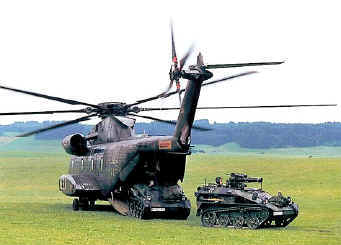 diverse firepower.
diverse firepower.
A Rhino will look similar to the German 4-ton Wiesel vehicle (right) but much heavier, up to 8 tons, to accommodate enough frontal armor to resist RPGs and up to 40mm cannon fire. Ideally, the side armor can offer that degree of protection as well with the same type of armored skirts used by the M-1 tank. This will allow crewmen to survive mines and roadside bomb attacks unharmed. This is possible because its armament is light and it will be very compact with internal space no larger than a bathtub.
Rhinos will have no turret to lessen weight and vulnerability. It will be relatively underpowered with a small engine to limit weight and space. It may have a maximum road speed of just 30 mph since Rhinos are not expected to dash across rough terrain as part of armored forces; this is just a slow ox that acts as a shield for infantrymen. It will also have a steel canopy with racks to carry their packs. This is an idea used during World War II, like the M2 light tank (pictured) but smaller Rhinos will have heavy armor.
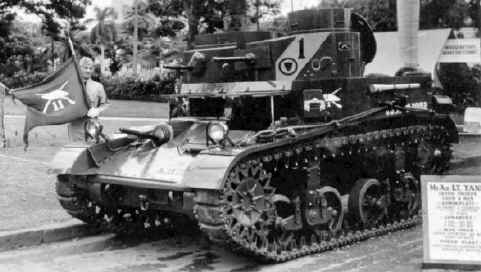 Rhinos
will be critical in close-in urban combat. Each infantry squad will
have its own Rhino that acts as a shield as they advance, providing direct
firepower as well. A Rhino will have a large fireman's step in the rear so several grunts can ride along.
A tripod on each side of the rear allows mounting of a light machine gun or recoilless
rifle. Perhaps
an entire squad will climb aboard when combat is light. Rhinos will prove their value in confined
areas like forests and small mountain roads. They will serve as a munitions
magnet, attracting fire from defenders who are puzzled and frightened by this
small indestructible "thing" that survives multiple hits from heavy
machine guns, roadside bombs, and RPGs. Meanwhile, fire support coordinators and
tanks following far behind Rhinos note the location of enemy fires and destroy
those targets. The picture shows Marines using a Sherman tank as a shield
during World War II.
Rhinos
will be critical in close-in urban combat. Each infantry squad will
have its own Rhino that acts as a shield as they advance, providing direct
firepower as well. A Rhino will have a large fireman's step in the rear so several grunts can ride along.
A tripod on each side of the rear allows mounting of a light machine gun or recoilless
rifle. Perhaps
an entire squad will climb aboard when combat is light. Rhinos will prove their value in confined
areas like forests and small mountain roads. They will serve as a munitions
magnet, attracting fire from defenders who are puzzled and frightened by this
small indestructible "thing" that survives multiple hits from heavy
machine guns, roadside bombs, and RPGs. Meanwhile, fire support coordinators and
tanks following far behind Rhinos note the location of enemy fires and destroy
those targets. The picture shows Marines using a Sherman tank as a shield
during World War II.
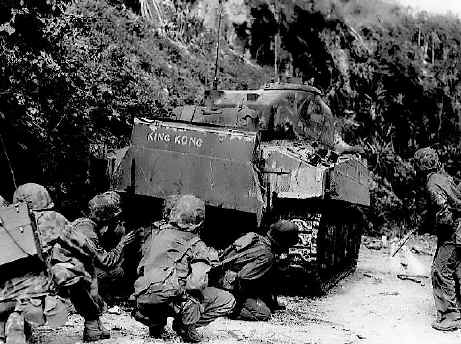 Grunts will love Rhinos since they
don't produce burning heat like the gas turbine M-1 tank, so it
is easy to follow behind. They can see over the top of a Rhino when
moving forward. The Rhino will train with grunts and take
care not to run them over. The gunner will have an excellent view in all
directions, and his knees will be next to the driver's shoulders so they will
develop an immediate tactile method to instantly maneuver in close
quarters. In addition, grunts will not worry about getting knocked out
from gun blasts, which is a major issue when a tank fires its 120mm main gun.
Grunts will love Rhinos since they
don't produce burning heat like the gas turbine M-1 tank, so it
is easy to follow behind. They can see over the top of a Rhino when
moving forward. The Rhino will train with grunts and take
care not to run them over. The gunner will have an excellent view in all
directions, and his knees will be next to the driver's shoulders so they will
develop an immediate tactile method to instantly maneuver in close
quarters. In addition, grunts will not worry about getting knocked out
from gun blasts, which is a major issue when a tank fires its 120mm main gun.
The second role for Rhinos is to support helicopter assaults. At less than 10 tons it can be flown internally by large helicopters like the CH-47 and CH-53. This will provide air-landed infantrymen with instant mobile firepower and an armored vehicle that can only be defeated by a lucky shot from a major caliber gun or large anti-tank missile. Lucky because the Rhino's tiny frontal section of sloped armor will be difficult to hit.
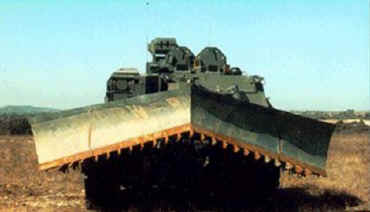 Rhino variants should be developed
for specific missions. Rhinos may have a dozer-type blade on their front to knock
down gates and doors, and to push cars, bomblets, and debris aside. It will be similar
to the larger blade used by the Grizzly engineer vehicle. (pictured) Rhinos can
drive down narrow streets, alleys, into warehouses, and across small bridges where
tanks cannot venture.
Rhino variants should be developed
for specific missions. Rhinos may have a dozer-type blade on their front to knock
down gates and doors, and to push cars, bomblets, and debris aside. It will be similar
to the larger blade used by the Grizzly engineer vehicle. (pictured) Rhinos can
drive down narrow streets, alleys, into warehouses, and across small bridges where
tanks cannot venture. 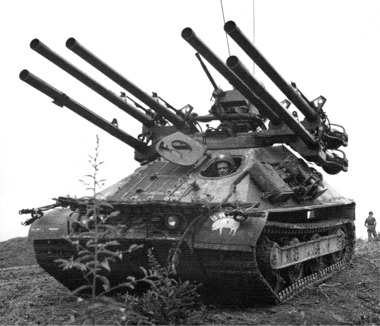
A Rhino with standard 70mm rocket pods atop would prove popular to blast enemy positions with instant, direct firepower, similar to the effective Ontos (pictured) that carried six 106mm recoiless rifles atop during the Vietnam war. In the Battle of Hue, Regimental Commander Colonel Stanley Hughes felt the Ontos was the most effective of all Marine supporting arms. Its mobility made it less vulnerable than tanks, which suffered heavy losses, while its recoilless rifles could knock holes in or completely knock down walls. The appearance of an Ontos was sometimes enough to make the enemy break and run. It was also sling loaded by CH-53 helicopters in later operations. A Rhino flamethrower version may also be useful. No modern army has anything like simple Rhinos in service, so all are ill-equipped for urban warfare and helicopter assaults.
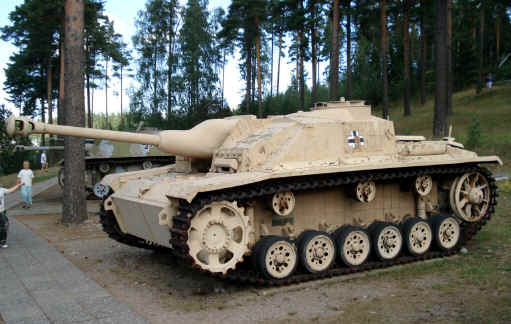 What
was the most common German tank in World War II?
Some people refuse to call it a tank since its had no turret, but the 24-ton StuG-III
(pictured) was Germany's most-produced armored fighting vehicle. It was employed
as an infantry support tank with a 75mm main gun and medium machine gun. Over 10,000 were built because they cost much less to
build and maintain since they lacked a complex turret. And since they lacked a
turret, their profile was lower and stronger, so they were more likely to
survive hits, just like Rhinos.
What
was the most common German tank in World War II?
Some people refuse to call it a tank since its had no turret, but the 24-ton StuG-III
(pictured) was Germany's most-produced armored fighting vehicle. It was employed
as an infantry support tank with a 75mm main gun and medium machine gun. Over 10,000 were built because they cost much less to
build and maintain since they lacked a complex turret. And since they lacked a
turret, their profile was lower and stronger, so they were more likely to
survive hits, just like Rhinos.
©2015 www.G2mil.com